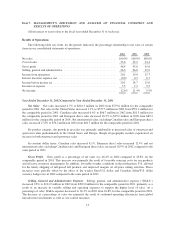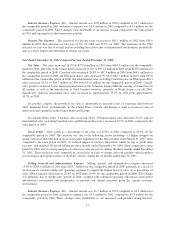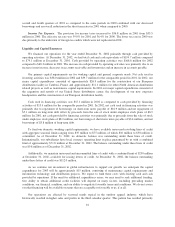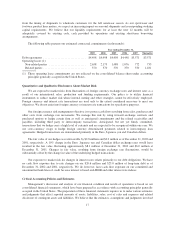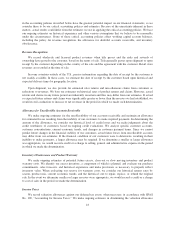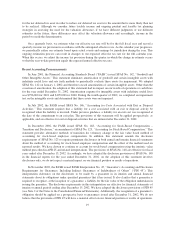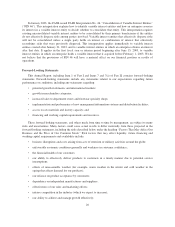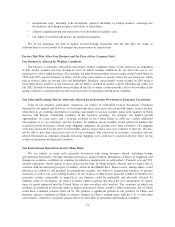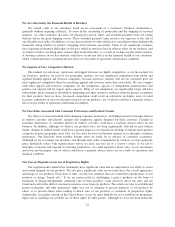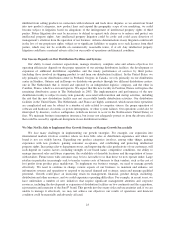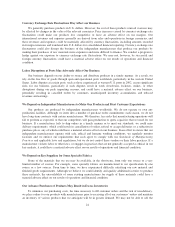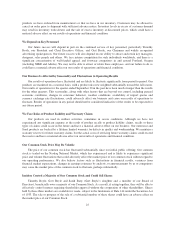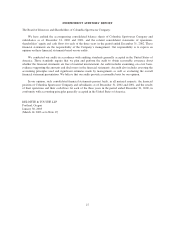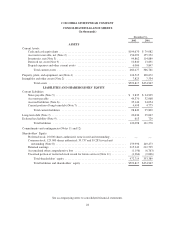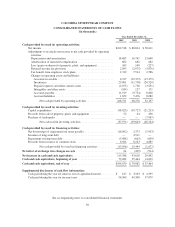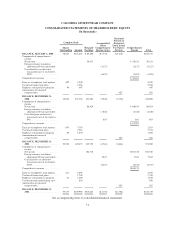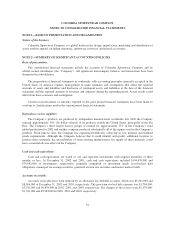Columbia Sportswear 2002 Annual Report Download - page 29
Download and view the complete annual report
Please find page 29 of the 2002 Columbia Sportswear annual report below. You can navigate through the pages in the report by either clicking on the pages listed below, or by using the keyword search tool below to find specific information within the annual report.We Are Affected by the Financial Health of Retailers
We extend credit to our customers based on an assessment of a customer’s financial circumstances,
generally without requiring collateral. To assist in the scheduling of production and the shipping of seasonal
products, we offer customers discounts for placing pre-season orders and extended payment terms for taking
delivery before the peak shipping season. These extended payment terms increase our exposure to the risk of
uncollectible receivables. In addition, we face increased risk of order reduction or cancellation when dealing with
financially ailing retailers or retailers struggling with economic uncertainty. Some of our significant customers
have experienced financial difficulties in the past, which in turn have had an adverse effect on our business, and
we believe retailers are being more cautious than usual with orders as a result of weakness in the retail economy.
A slowing economy in our key markets could have an adverse effect on the financial health of our customers,
which could in turn have a material adverse effect on our results of operations and financial condition.
We Operate in Very Competitive Markets
The markets for outerwear, sportswear and rugged footwear are highly competitive, as are the markets for
our licensees’ products. In each of our geographic markets, we face significant competition from global and
regional branded apparel and footwear companies. In many instances, retailers who are our customers pose our
most significant competitive threat by marketing apparel and footwear under their own labels. We also compete
with other apparel and footwear companies for the production capacity of independent manufacturers that
produce our apparel and for import quota capacity. Many of our competitors are significantly larger and have
substantially greater financial, distribution, marketing and other resources and have achieved greater recognition
for their products than we have. Increased competition could result in reductions in display areas in retail
locations, reductions in sales or reductions in prices of our products, any of which could have a material adverse
effect on our results of operations and financial condition.
We Face Risks Associated with Consumer Preferences and Fashion Trends
We believe we have benefited from changing consumer preferences, including increased consumer interest
in outdoor activities and lifestyle changes that emphasize apparel designed for these activities. Changes in
consumer preferences or consumer interest in outdoor activities could have a material adverse effect on our
business. In addition, although we believe our products have not been significantly affected by past fashion
trends, changes in fashion trends could have a greater impact as we expand our offerings to include more product
categories in more geographic areas Also, we face risks because our business requires us to anticipate consumer
preferences. Our decisions about product designs often are made far in advance of consumer acceptance.
Although we try to manage our inventory risk through early order commitments by retailers, we must generally
place production orders with manufacturers before we have received all of a season’s orders. If we fail to
anticipate accurately and respond to consumer preferences, we could experience lower sales, excess inventories
and lower profit margins, any of which could have a material adverse effect on our results of operations and
financial condition.
Our Success Depends on our use of Proprietary Rights
Our registered and common law trademarks have significant value and are important to our ability to create
and sustain demand for our products. We also place significant value on our trade dress, the overall appearance
and image of our products. From time to time, we discover products that are counterfeit reproductions of our
products or design “knock offs.” If we are unsuccessful in challenging a party’s products on the basis of
trademark or design infringement, continued sales of these products could adversely affect our sales and our
brand and result in the shift of consumer preference away from our products. The actions we take to establish and
protect trademarks and other proprietary rights may not be adequate to prevent imitation of our products by
others or to prevent others from seeking to block sales of our products as violations of proprietary rights.
Additionally, in markets outside of the United States, it may be more difficult for us to establish our proprietary
rights and to challenge successfully use of those rights by other parties. Although we have not been materially
22




